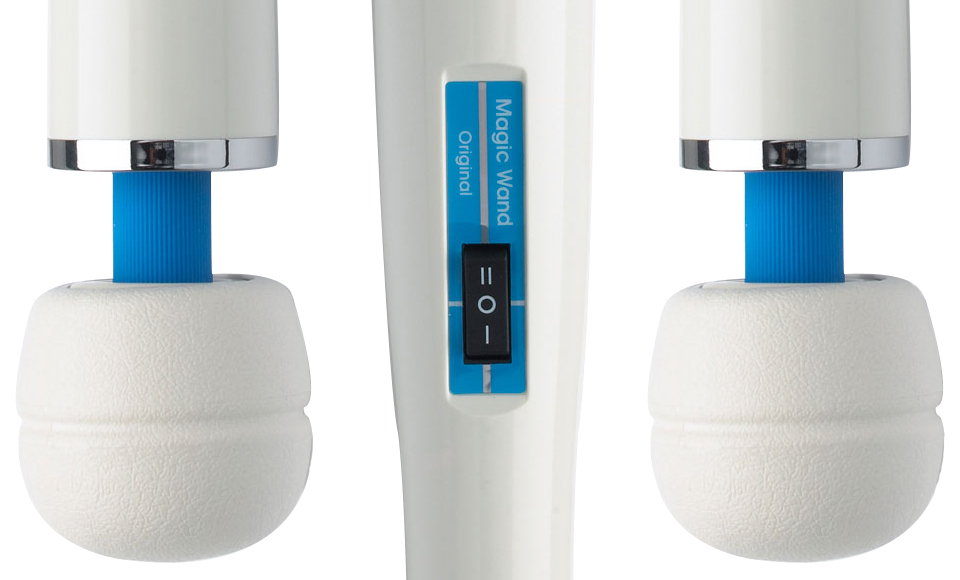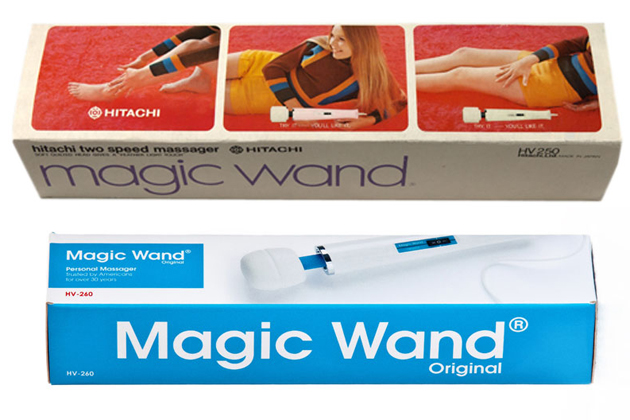
1968. It was the year of the Tet Offensive; of Martin Luther King Jr.'s and Robert Kennedy's assassinations; of the Democratic National Convention riots. It was also the first time humans had photographed the Earth from deep space. It was a year of great innovation and devastation. American values were in upheaval and the sexual revolution was well underway, calling into question outmoded sexual stereotypes.
In the midst of all of this, an unlikely star was born.

The US Patent and Trademark Office lists the Hitachi Magic Wand's first use in commerce as April 25th, 1968. In the 46 years since, this big, white hunk of plug-in plastic, which bears some resemblance to a bass drum mallet, has come to represent an awkward duality for many Americans. It's marketed and sold as a personal massager in department stores and pharmacies, while also serving as a trusted masturbation aid.
The Magic Wand isn't what you'd expect from a modern sex toy. In fact, it could very well be your grandmother's vibrator. It weighs 1.2 pounds, measures 12 inches from base to tip and has a bulbous, "tennis ball-sized" head. It's made of hard plastic, has two speeds -- high (6,000 vibrations per minute) and low (5,000 vibrations per minute) -- and connects to a power outlet via a 6-foot cord. It's neither waterproof, nor water-resistant and has a tendency to overheat after 25 minutes of use. Shortcomings aside, the Magic Wand continues to outsell more technologically advanced competitors, even as the company that created it distances itself from what has become one of the most iconic sex toys in existence.
The same year the Magic Wand appeared on the market, a New York-based artist by the name Betty Dodson had her first sexually explicit one-woman exhibition at the Wickersham Gallery on Madison Avenue. According to Dodson, often attributed with single-handedly popularizing the device, the show's opening marked her foray into sex education. Four years later, she launched a series of instructional classes called Bodysex Workshops, where she used vibrators to teach women about masturbation, and in 1974 she released her first book, Liberating Masturbation. Dodson, like so many women at the time, sought sex toys in rather conventional venues.
"Electric vibrators were sold as massage machines and I bought them in the small-appliance section of Macy's," Dodson said.
While Liberating Masturbation was sold alongside the Magic Wand at Eve's Garden, a new and rather subversive sex shop that catered specifically to women, Dodson opted for the Panasonic Panabrator in her early demos. It wasn't until 1975 that she replaced it with the Magic Wand. According to Dian Hanson, former editor of Juggs, Leg Show and various other men's magazine, and current Sexy Book Editor at Taschen publishing, Dodson turned her on to the Wand in 1977 and she's been a devotee ever since.
"She told me to get a Hitachi Magic Wand, but to be careful of its power, both physical and psychological, as it's an addictive agent right behind heroin," Hanson said. "My only previous vibrator experience was a pink plastic thing that held two D-cell batteries and the Hitachi was a whole 'nother world."
Hanson's reaction to the Magic Wand isn't unique. The internet is flooded with accounts of its strength, versatility and staying power. It's commonly referred to as the Cadillac of vibrators and has been a best-seller at progressive sex shop Good Vibrations since it opened in 1977. It's moved from ads in the back of the liberal political rag Mother Jones in the '80s to being the punchline on an episode of Louie earlier this year. In the meantime, it's become a regular in the pages of women's magazines like Cosmo, appeared as a trusty sidekick in adult films and spawned an army of unauthorized offspring. In the near 50 years since its birth, technological advances have led to massive leaps in consumer technology, but the Magic Wand has remained largely unchanged.
That is until last summer. Hitachi ditched the old, 1980s packaging, retooled the materials for a lighter, more durable product and switched out the circuit board. To the uninitiated, it looked just like mom's old Magic Wand, with one notable exception: The Hitachi name was nowhere to be found.
The Magic Wand occupies a special place in the history of both female sexuality and consumer electronics, but it's neither the first device of its kind to be marketed as a personal massager, nor the first produced by a leader in the electronics industry. GE sold its own, as did Panasonic and Oster (best known for its blenders). According to Rachel P. Maines' The Technology of Orgasm, the first electronic vibrator appeared in 1878, predating radio, television and a slew of other groundbreaking technologies. Maines describes a device, powered by a massive battery, invented by an English physician named Joseph Mortimer Granville and manufactured by Weiss, a medical instrument manufacturer.
Weiss' motorized merrymaker was first used to treat hysteria, an antiquated medical condition thought to be cured through female orgasm. As Maines points out, by the early 1900s, there were dozens of models on the market, and their uses had expanded to include treatment for everything from arthritis and constipation to sore muscles.

Since Mortimer Granville invented the first electric vibrator, they've successfully penetrated the mainstream with appearances in major motion pictures, popular TV shows and fashion magazines. Even Oprah Winfrey's not afraid to speak her mind on the subject. (Apparently the big O prefers something the size of a "perfume sprayer" to outsized back massagers like the Magic Wand.) Attitudes toward sex and sex toys have changed drastically, but no other vibrator has captured the mainstream imagination like the Magic Wand, save for maybe the multi-pronged Rabbit, which had its own turn in the spotlight on an episode of Sex and the City.
With the help of mainstream media, serious discussions about masturbation have moved from the confines of women's sexuality workshops to the national level. In 1994, then-Surgeon General Joycelyn Elders, already a controversial figure, was forced to resign after suggesting that schoolchildren be taught to masturbate to curb the spread of AIDS. We've come a long way since Elders' ouster; archaic laws restricting the sale of sex toys have slowly dropped from the books and public figures like Oprah have legitimized the subject in mainstream media, but masturbation and its accoutrement are still taboo. In fact, information about the Magic Wand is hard to come by outside of personal anecdotes and the device's official site. MagicWandOriginal.com contains a list of specs, user reviews and a vague history of the device, but zero mention of its origins.
It appears that silence is no mistake. We reached out to Hitachi multiple times while researching this story and received no answer. In fact, according to Eddie Romero, director of operations for Vibratex, the primary US importer of the device, Hitachi was ready to pull the plug entirely before last summer's redesign. As he puts it, Hitachi is a "very traditional" Japanese company and didn't want its name attached to what is essentially the most recognizable sex toy on Earth. Vibratex, not ready to lose its biggest moneymaker (it's sold 250,000 units since last summer), convinced Hitachi to continue producing it as the Original Magic Wand.
"Evidently, Mr. Hitachi Sr. didn't like the idea that his massage machine was giving millions of women orgasms," Dodson said. "Tough shit! It remains my favorite vibrator to this day."
by Christopher Trout | @Mr_Trout
------------------------------------------------
Hanson's reaction to the Magic Wand isn't unique. The internet is flooded with accounts of its strength, versatility and staying power. It's commonly referred to as the Cadillac of vibrators and has been a best-seller at progressive sex shop Good Vibrations since it opened in 1977. It's moved from ads in the back of the liberal political rag Mother Jones in the '80s to being the punchline on an episode of Louie earlier this year. In the meantime, it's become a regular in the pages of women's magazines like Cosmo, appeared as a trusty sidekick in adult films and spawned an army of unauthorized offspring. In the near 50 years since its birth, technological advances have led to massive leaps in consumer technology, but the Magic Wand has remained largely unchanged.
That is until last summer. Hitachi ditched the old, 1980s packaging, retooled the materials for a lighter, more durable product and switched out the circuit board. To the uninitiated, it looked just like mom's old Magic Wand, with one notable exception: The Hitachi name was nowhere to be found.
The Magic Wand occupies a special place in the history of both female sexuality and consumer electronics, but it's neither the first device of its kind to be marketed as a personal massager, nor the first produced by a leader in the electronics industry. GE sold its own, as did Panasonic and Oster (best known for its blenders). According to Rachel P. Maines' The Technology of Orgasm, the first electronic vibrator appeared in 1878, predating radio, television and a slew of other groundbreaking technologies. Maines describes a device, powered by a massive battery, invented by an English physician named Joseph Mortimer Granville and manufactured by Weiss, a medical instrument manufacturer.
Weiss' motorized merrymaker was first used to treat hysteria, an antiquated medical condition thought to be cured through female orgasm. As Maines points out, by the early 1900s, there were dozens of models on the market, and their uses had expanded to include treatment for everything from arthritis and constipation to sore muscles.

Since Mortimer Granville invented the first electric vibrator, they've successfully penetrated the mainstream with appearances in major motion pictures, popular TV shows and fashion magazines. Even Oprah Winfrey's not afraid to speak her mind on the subject. (Apparently the big O prefers something the size of a "perfume sprayer" to outsized back massagers like the Magic Wand.) Attitudes toward sex and sex toys have changed drastically, but no other vibrator has captured the mainstream imagination like the Magic Wand, save for maybe the multi-pronged Rabbit, which had its own turn in the spotlight on an episode of Sex and the City.
With the help of mainstream media, serious discussions about masturbation have moved from the confines of women's sexuality workshops to the national level. In 1994, then-Surgeon General Joycelyn Elders, already a controversial figure, was forced to resign after suggesting that schoolchildren be taught to masturbate to curb the spread of AIDS. We've come a long way since Elders' ouster; archaic laws restricting the sale of sex toys have slowly dropped from the books and public figures like Oprah have legitimized the subject in mainstream media, but masturbation and its accoutrement are still taboo. In fact, information about the Magic Wand is hard to come by outside of personal anecdotes and the device's official site. MagicWandOriginal.com contains a list of specs, user reviews and a vague history of the device, but zero mention of its origins.
It appears that silence is no mistake. We reached out to Hitachi multiple times while researching this story and received no answer. In fact, according to Eddie Romero, director of operations for Vibratex, the primary US importer of the device, Hitachi was ready to pull the plug entirely before last summer's redesign. As he puts it, Hitachi is a "very traditional" Japanese company and didn't want its name attached to what is essentially the most recognizable sex toy on Earth. Vibratex, not ready to lose its biggest moneymaker (it's sold 250,000 units since last summer), convinced Hitachi to continue producing it as the Original Magic Wand.
"Evidently, Mr. Hitachi Sr. didn't like the idea that his massage machine was giving millions of women orgasms," Dodson said. "Tough shit! It remains my favorite vibrator to this day."
by Christopher Trout | @Mr_Trout
------------------------------------------------




